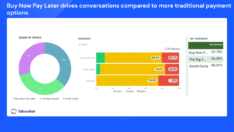Talkwalker study: embracing digital disruption to the finance and payments ecosystem
Today’s payments market sees cash rendered redundant, as a third player cements its place at the register: buy now pay later. A Talkwaker study has found ways brands can foster customer loyalty in the face of these new contenders.
Consumer intelligence platform Talkwalker has analysed Australian social media trends and conversations throughout 2022 to gain insight into the impact new players are having on the sector.


